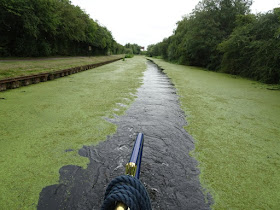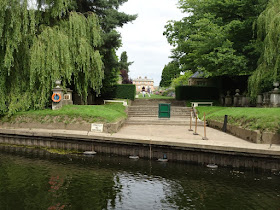 |
| The flood lock at West Haddlesey was open to the river so, after a stop for lunch in this delightful spot, we cruised straight through and up the river to a mooring above Beal Lock for the night. |
 |
| We turned right onto the river but looking left Eggborough Power Station dominates the view. |
 |
| We spent Saturday night at Lemonroyd and moved just a mile or so to Woodlesford on Sunday. Here we are waiting below Woodlesford Lock. |
 |
| We set off for Leeds on Monday morning, joining a tug and a huge work barge in Fishponds Lock but there was plenty of room as these locks are 200 feet long and 20 feet wide. |
 |
| The tug went ahead of us to pick up this barge heavily laden with stone. The thrust as he started to push the barge sent Leo skittering sideways. Plenty of power there! |
 |
| The river was on amber when we arrived but in fact it did not go any higher. |
 |
| We haven't had much time left for sightseeing but we did find a dinosaur in Leeds Indoor Market. And it was moving! |
 |
| There are some Damien Hirst statues in the city. This one is called 'The Anatomy of an Angel'. Bits of her insides are on view. |
 |
| Damien Hirst seems to like depicting the human anatomy. This huge chap is in Briggate. More colourful than the angel but the eye is a bit intimidating. |





























































